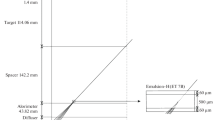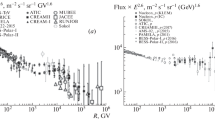Abstract
More than a thousand interactions of primary heavy nuclei of the cosmic radiation with charge ≥10 and energy >1 GeV nucleon−1 in nuclear emulsion have been studied with emphasis on how the primary nucleus fragments. It has been determined that the cases of multiple successive fragmentations that have been observed do not occur more frequently than expected. The fragmentation ofZ>20 nuclei does depend on the target nucleus to some extent so it is important to try to separate the interactions in emulsion by theirN h (number of evaporation prongs). The fragmentation of 168 O at 2.1 GeV nucleon−1 measured at the Bevalac shows a similar dependence on target nucleus. By using data from these new interactions combined with published data we have simulated on a computer nuclear cascades in both emulsion and air. Results on these cascades are given for both primary silicon and primary iron nuclei. These results are used to discuss the fluctuations expected in extensive air showers produced by heavy primary nuclei.
Similar content being viewed by others
References
Andersson, B., Otterlund, I., and Kristiansson, K.: 1966,Arkiv. Fysik 31, 527.
Badhwar, G. D., Durgaprasad, N., and Vijayalakshmi, B.: 1965,Proc. Ind. Acad. Sci. 61, 374.
Cleghorn, T.F., Freier, P. S., and Waddington, C. J.: 1968,Can. J. Phys. 46, 5572.
Dixon, H. E., Turver, K. E., and Waddington, C. J.: 1974,Proc. Roy. Soc. London,A339, 157.
Dixon, H. E., Earnshaw, J. C., Hook, J. R., Smith, G. J., and Turver, K. E.: 1973,Proc. Denver Cosmic Rays Conf. 4, p. 2473.
Fowler, P. H., Hillier, R. R., and Waddington, C. J.: 1957,Phil. Mag. 2, 293.
Friedlander, E., and Spirchez, M.: 1961,Nucl. Sci. Abstr. 15, 3457.
Friedlander, M. W., Neelakantan, R. A., Tokunaga, S., Stevenson, G. R., and Waddington, C. J.: 1963,Phil. Mag. 8, 1691.
Hillier, R. R. and Waddington, C. J.: 1957,Nuovo Cimento 6, 403.
Judek, B.: 1968,Can. J. Phys. 46, 343.
Judek, B.: 1972,Can. J. Phys. 50, 2082.
Lindstrom, P. J., Greiner, D. E., Heckman, H. H., Cork, B., and Bieser, F. S.: 1973, paper presented atSymposium on Isotopic Composition, Durham, New Hampshire, also LBL-3650 preprint.
Milone, A.: 1954,Suppl. Nuovo Cimento 12, 354.
Rajopadhye, V. Y. and Waddington, C. J.: 1958,Phil. Mag. 3, 19.
Tokunaga, S., Ishii, T., and Nishikawa, K.: 1957,Nuovo Cimento 5, 517.
Waddington, C. J.: 1960,Phil. Mag. 5, 311.
Yagoda, H.: 1956,Bull. Am. Phys. Soc. II64.
Yagoda. H.: 1958,Geophys. Res. Papers, No. 50.
Author information
Authors and Affiliations
Additional information
This work was supported by the Office of Naval Research under Contract No. N00014-67-A-0113-0021. One of us, C. J. Waddington, is indebted to the Science Research Council of the United Kingdom and Professor H. H. Elliot for support and hospitality while visiting Imperial College, London, where the computer simulations were performed.
Rights and permissions
About this article
Cite this article
Freier, P.S., Waddington, C.J. The cascading of cosmic-ray nuclei in various media. Astrophys Space Sci 38, 419–436 (1975). https://doi.org/10.1007/BF00647143
Received:
Revised:
Issue Date:
DOI: https://doi.org/10.1007/BF00647143




